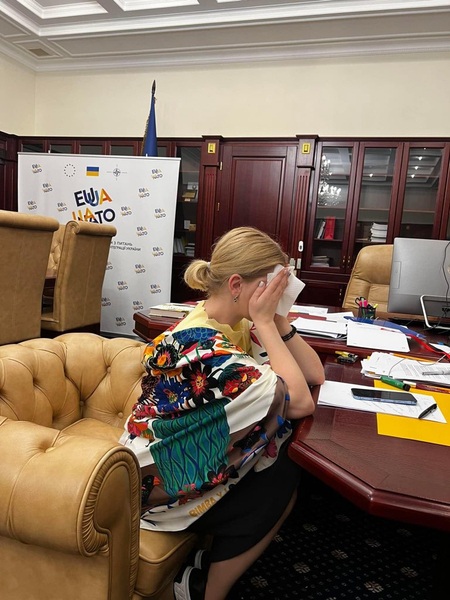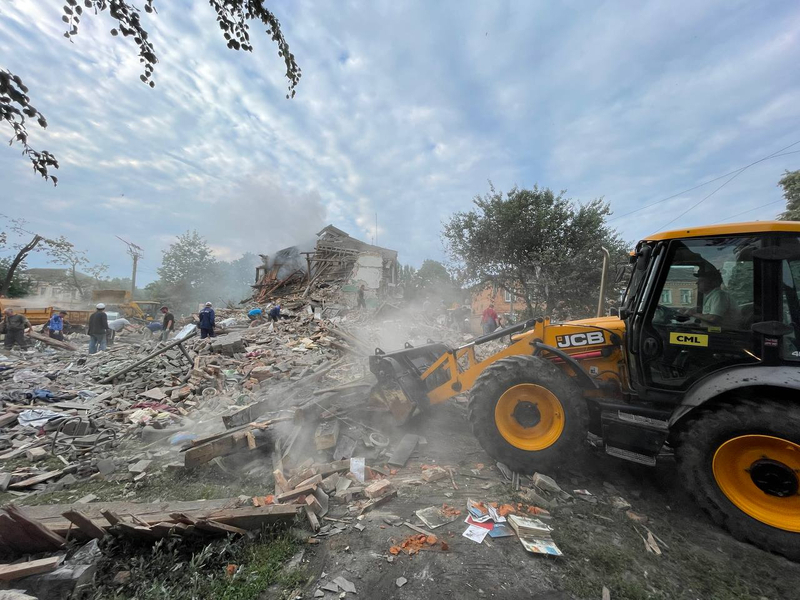Getting the candidate status for EU membership on 23 June 2022 for Ukraine and Moldova was far more than a symbolic gesture. For the first time in its history Ukraine has the prospect of a European future, says Andreas Umland. But there is a long way to go and Ukraine needs help and support. In the end it might strengthen the EU substantially.
 Olga Stefanishyna, vice prime minister of Ukraine, responsible for EU integration, in tears after the granting of candidate EU membership for Ukraine (picture twitter)
Olga Stefanishyna, vice prime minister of Ukraine, responsible for EU integration, in tears after the granting of candidate EU membership for Ukraine (picture twitter)
With the granting of candidate status by the European Council on 23 June 2022, Ukraine and Moldova skipped a preliminary stage in the EU enlargement process. Until then, they had not been given an explicit membership perspective; this was granted to the two countries and Georgia on the same day by the EU's highest decision-making body.
Unlike Georgia, Kosovo and Bosnia and Herzegovina, Ukraine and Moldova are now not only potential, but already fully-fledged EU candidate countries. The two countries thus moved, within the EU accession process, directly to the same level as Albania, Northern Macedonia, Montenegro, Serbia and Turkey.
A few weeks before this decision, such a success seemed unlikely for Kyiv and Chişinău, given mixed signals from various European capitals. A decisive role in the eventual consensus of the 27 member states was apparently played by the joint visit of the French and Romanian presidents, Italian prime minister and German chancellor to Kyiv shortly before, and their demonstrative support there for Ukraine's EU bid.
The collective pro-Ukrainian statement by Olaf Scholz, Mario Draghi, Klaus Johannis and Emmanuel Macron in Kyiv sent an important signal to the other national governments of the EU. It probably prevented a possible veto by several doubting member states of the Union, i.e. a limitation of the Council decision to a mere potential candidacy for Ukraine and Moldova, as was decided for Georgia.
This means that for Kyiv and Chişinău the path to EU accession is now marked out. The main task ahead is, however, only slightly different in substance from that of the last six years: the implementation of the Association Agreements of Ukraine, Moldova and Georgia with the EU, which were signed in 2014 and entered into force in 2016.
In terms of their contents, these agreements are already roadmaps for integration and not just association of the three countries with the Union. In this respect, Georgia's lower formal status as a potential candidate since 23 June compared to the other two members of the Association Trio has only minor practical effects. For all three states, without distinction, the implementation of their Association Agreements remains the royal road to the EU.
Break new ground
But there are other instruments that Kyiv can use to strengthen its own and Europe's resilience. As a large and growingly respected state in the context of its successful defence against Russia, Ukraine has a new role to play in the Western concert of powers. With its novel potential, Ukraine should try to break new ground in its own rapprochement with the EU as well as in the European support for its resilience. Moreover, Kyiv should try continuing to take Moldova and Georgia with it, as it has already done during the last four monhts with regard to obtaining EU membership prospects.
Firstly, for the three countries, inclusion in at least parts of the network of institutions originally created by the EU for the Balkan states in preparation for EU accession is now an obvious option. This concerns the following structures that have been active in the Western Balkans for many years already: the Regional Cooperation Council (RCC), Central European Free Trade Agreement (CEFTA), Regional Anti-Corruption Initiative (RAI), South East European Health Network (SEEHN), Regional Rural Development Standing Working Group of South Eastern Europe (SWGRRD), Public Employment Service Centre for South East European Countries (CPESSEC), Regional Youth Cooperation Centre (RYCO), South East European Law Enforcement Centre (SELEC), Centre for Security Cooperation (RACVIAC), Education Reform Initiative for South East Europe (ERISEE), Regional School of Public Administration (RESPA), Regional Disaster Preparedness Centre (DPPI), South East European Centre for Entrepreneurial Learning (SEECEL), Centre of Excellence for Finance (CEF) and Regional Environmental Centre (REC).
Liberalise laws
Secondly, Ukraine, like Georgia before it, should liberalise its hitherto complicated settlement and labour law for immigrants from EU member and certain other countries (USA, Canada, UK, Norway, Switzerland, Australia, etc.). The right of settlement for all EU citizens is in any case included in the Union membership to which Ukraine aspires. Similar to its initially unilateral liberalisation of entry regulations for EU citizens in 2005, Ukraine could again unilaterally and before EU accession simplify its settlement rules for foreigners from friendly countries. An automatic multi-year residence, study, trade and work permit could be provided upon registration of a living address in Ukraine. This could already be important for individual foreign military and development workers in Ukraine's current state of war. After a ceasefire has been reached, this would facilitate the activities of Western organisations and investors in Ukraine.
 Random Russian bombing of Chuguyev in Ukraine, July 2022 (picture twitter)
Random Russian bombing of Chuguyev in Ukraine, July 2022 (picture twitter)
Thirdly, with the attainment of candidate status, a combination of the EU aid envisaged in this accession stage with other existing as well as future Western integration, investment and reconstruction programmes may have synergetic effects. Ukraine, Moldova and Georgia, for example, should seek to be included in the Three Seas Initiative of the eastern EU member states. Ukraine could benefit from the fact that the "Marshall Plan" for the reconstruction of the country foresees substantial transfers from various Western countries and organisations to Kyiv.
These funds could be used not only to support general reforms and adjustments in the country's EU accession process. They could also geographically and technically expand ongoing or new transnational infrastructure and energy projects of the Three Sea Initiative in Eastern Europe and the Black Sea region. Another part of the apparently large future Western financial assistance could be used to form political risk insurance for foreign private investors in Ukraine, possibly with the involvement of the World Bank group's Multilateral Investment Guarantee Agency (MIGA).
Pan-European coordination
Fourth, Ukraine can use its voice in the world, which has become more audible in recent months, to help develop pan-European coordination and decision-making processes of pro-Western countries in its own interest. There have been published a number of new proposals from Western European politicians and experts in recent months. These ideas for expanding Europe’s current institutional structure aim to complement older transregional organisations, such as the Council of Europe and the OSCE, and to achieve European political integration beyond the borders of the EU. Such proposals have particular significance for Kyiv. They discuss new structures that can provide bodies for Ukraine to dovetail the pursuit of its security and other interests with key Western partner states, even before EU and/or NATO accession (Klimkin & Umland 2020).
Former Italian Prime Minister Enrico Letta made a first pitch on 25 April 2022 with a draft for a European Confederation (ECF) of the 36, i.e. EU, Western Balkans & Association Trio states. French President Emmanuel Macron followed with a plan for a European Political Community (EPC) of the Union member states with several non-EU countries on 9 May 2022. A good week later, European Council President Charles Michel presented his idea for a European Geopolitical Community (EGC) from "Reykjavik to Baku or Yerevan, from Oslo to Ankara".
Possibly the most feasible proposal was made in June 2022 by two German political scientists in a paper by the Vienna Institute for the Danube Region and Central Europe (Schneckener & Schäffer 2022). They recommended the creation of a Greater European Council (GEC). This multilateral body could include the European Council with its 27 members as well as the six Western Balkan states and the Association Trio, but possibly also Turkey, Norway, Great Britain, Iceland and/or Switzerland. It could meet before or after the European Council meetings and be chaired by the EC President and a rotating representative of the non-EU states.
Ukraine would be the country that would benefit most from such a structure. Whether ECF, EPC, EGC or GEC, Kyiv's inclusion in a new pan-European institution would make the current geopolitical grey zone in which the country will remain until it joins the EU or/and NATO less grey (Vereshchuk & Umland 2019). The same applies to the geopolitics of the Republic of Moldova and Georgia, and to some extent also to the Western Balkan states. At the same time, the voice of Ukraine and especially its President Volodymyr Zelenskyy is currently being heard far beyond the borders of Europe. Kyiv should use this peculiar potential to push for the creation of a new pan-European structure in the interest of itself and the entire West.
References:
Pavlo Klimkin and Andreas Umland, “How to Progress Ukraine's Western Integration as a Prelude to Accession to the EU and NATO,” UI Paper, No. 4, 2020. https://www.ui.se/butiken/uis-publikationer/ui-paper/2020/how-to-progress-ukraines-western-integration-as-a-prelude-to-accession-to-the-eu-and-nato/.
Ulrich Schneckener and Sebastian Schäffer, “The Day After - Towards a Greater European Council?” IDM Policy Paper Series, No. 2, 2022. www.idm.at/idm-news/item/idm-pps-2-2022-the-day-after-towards-a-greater-european-council.
Iryna Vereshchuk and Andreas Umland, “How to Make Eastern Europe's Gray Zone Less Gray,” Harvard International Review, 23 August 2019. hir.harvard.edu/how-to-make-eastern-europe's-gray-zone-less-gray/.
Dr Andreas Umland is an analyst at the Stockholm Centre for Eastern European Studies (SCEEUS) of the Swedish Institute of International Affairs (UI).
